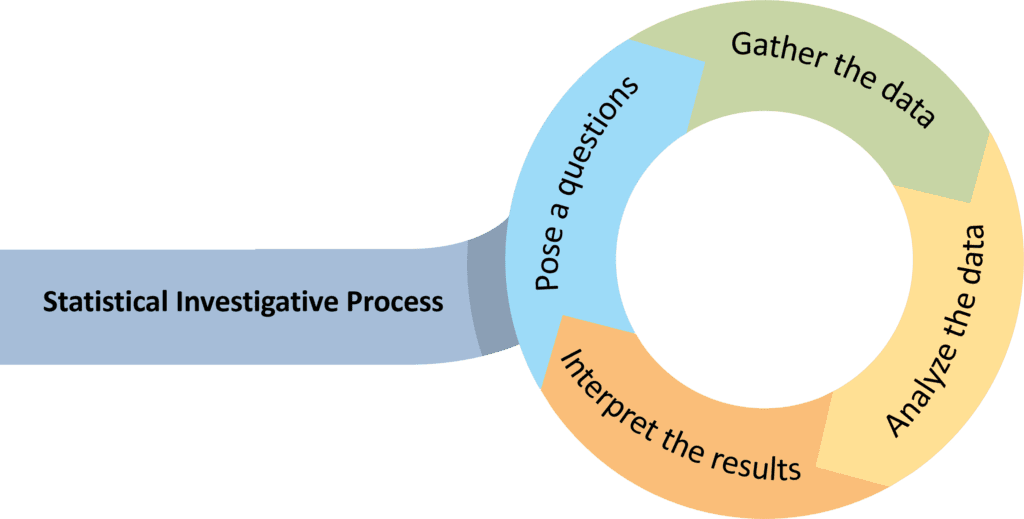Imagine for a moment that you’ve just opened your favorite weather app. You see there’s a 90% chance of rain. Without a second thought, you grab your umbrella as you head out for the day. Now, have you ever stopped to think about how that app knows it’s going to rain? The answer lies in the amazing world of statistics! Yes, you heard me right, statistics. It’s not a topic we talk about over dinner or a casual chat, but it’s incredibly powerful and underpins many decisions we make every day!
Think about the times you’ve made choices based on ‘most popular’ or ‘most viewed’, or even opted for the product that ‘4 out of 5’ people prefer. All of these are statistical conclusions that guide our daily choices.
The statistical investigative process is a fascinating process that converts raw data into valuable insights that can influence our decisions, shape our opinions, and even predict our futures! From forecasting weather to predicting market trends, it’s a tool that helps us navigate our world more confidently.
Answering Questions with Data
The statistical investigative process is a tool that helps us answer questions by leveraging the power of data. It provides a roadmap outlining the necessary steps to follow.
A Structured Approach
The first way the statistical investigative process helps us is by providing a structured approach. This structured approach ensures that researchers stay on track and maintain a logical flow throughout the investigation.

Step 1: Pose a question. A clear and focused inquiry serves as the starting point. By formulating a specific question, researchers can define the scope of their investigation and direct their efforts accordingly.
Step 2: Gather the data. Collecting relevant data could involve conducting surveys, experiments, or analyzing existing datasets. The data collected should be reliable, accurate, and directly related to the research question. By carefully selecting and gathering appropriate data, researchers ensure that they have a solid foundation for their analysis.
Step 3: Analyze the data. Once the data is collected, researchers move on to analyzing it. This involves applying statistical techniques and tools to identify patterns, relationships, and trends within the data. Through analysis, researchers can extract valuable insights and draw conclusions.
Step 4: Interpret the results. This involves making sense of the findings obtained through analysis. Researchers evaluate the implications of the results, draw meaningful conclusions, and communicate their findings effectively. This interpretation helps us understand the story the data tells and allows us to draw valid and reliable conclusions.
Making Better Decisions
The statistical investigative process is not only about finding answers; it also helps us make better decisions based on evidence. The statistical investigative process used relies on evidence over assumptions. When faced with questions or problems, relying on guesswork or assumptions is easy. However, the statistical investigative process encourages us to base decisions on evidence. By gathering and analyzing data, we can make informed choices supported by factual information. This evidence-based decision-making approach reduces uncertainty, minimizes biases, and increases the likelihood of making sound decisions.
Case Study – Planning a Company Retreat
Let’s look at how Alex, a young team leader in a company, took on the task of planning the annual company retreat. The challenge? Pick a location that most of the 500 employees would enjoy and stay within the set budget.
Alex thought, “Why not use some basic data analysis to help decide?”
Alex began with a simple question: “Where do most employees want to go for our annual retreat, and how much are they comfortable spending?”
To gather the needed information, Alex created a short survey. It asked employees to choose their top three locations from a list and indicate how much they thought was reasonable for the retreat.
After getting many answers, Alex started analyzing the data. He found out the average amount employees felt was okay to spend and saw which locations were the most popular.
From the survey, the top three choices were a city tour, a beach resort, and a mountain cabin trip. But when Alex looked at the average budget, he saw that only the city tour was affordable.
With this data, Alex talked to the management team and explained his findings. His decision was backed by real data, making it easier for everyone to agree.
The result? The company retreat was a big hit! Most employees loved the city tour, and the event stayed within budget. Thanks to Alex’s simple use of data analysis, the retreat was both fun and cost-effective. This shows how using data can help make smart decisions in the business world!